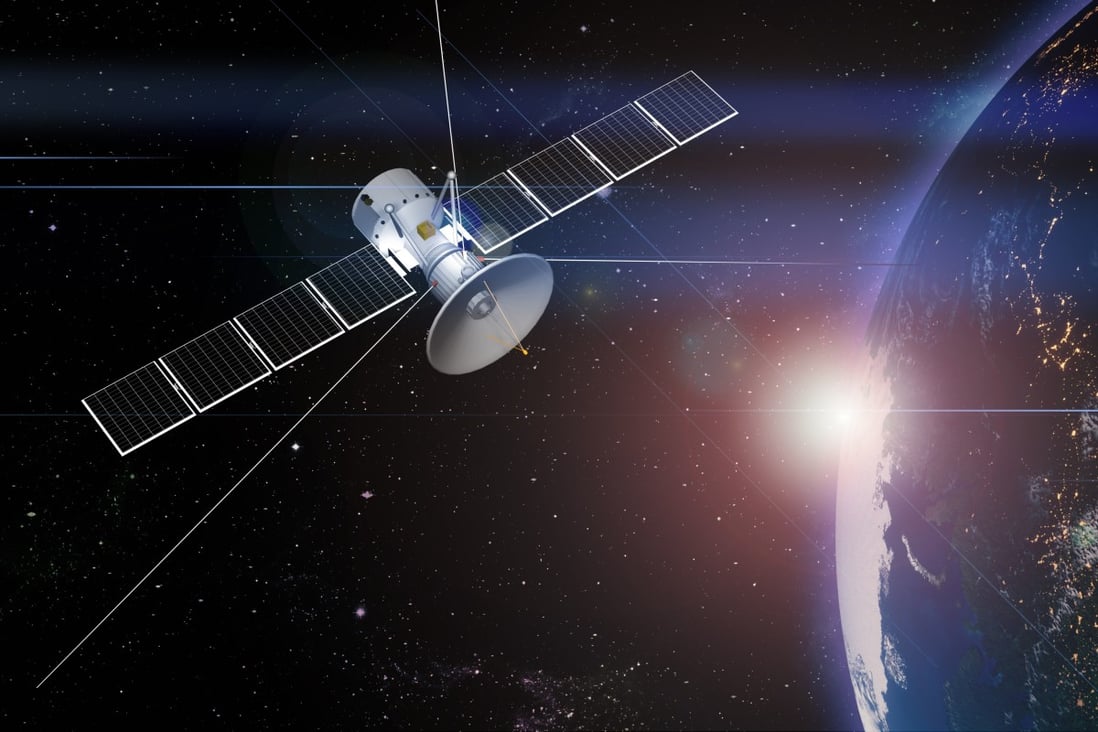China space laser zaps competition with data speed record: paper
- Beijing-based team says its technology can connect satellites to beam six films a second coast-to-coast, from a device smaller than a suitcase
- Engineers use ‘rule-breaking’ innovations to achieve transmission speeds of 10 gigabits per second in on-ground testing
in Beijing
Published: 11:00am, 26 Apr, 2022
Updated: 11:00am, 26 Apr, 2022

Chinese space engineers are developing technology to help satellites identify each other and establish a “handshake” in just 12 seconds. Photo: Shutterstock
A team of engineers in Beijing has developed a small laser that they say will allow satellites to communicate over long distances at significantly faster speeds than similar technology currently available.
The technology is fast enough to send six high-definition films from Seattle to New York in less than a second, according to research team leader Yang Jian, director of advanced communication technology with defence industry contractor the Beijing Institute of Remote Sensing Equipment.
In a paper published last week in domestic peer-reviewed journal Optical Communication Technology, Yang and his colleagues said the device – smaller than a suitcase and weighing just 12kg (26.4lbs) – would help China build a massive internet-like structure in Earth’s near-orbit and beyond.
The technology was initially developed for an unnamed space project and has a working range of more than 4,000km (2,485 miles), with an average speed of 10 gigabits per second.
In contrast, Japan’s JDRS-1 laser satellite – launched in 2020 to relay data between spy satellites – can reach up to 1.8 gigabits per second, while the US military’s Next Generation Space Architecture plans to achieve a global network of laser satellites with a bandwidth of from 250 megabits per second to one gigabit by 2028.
The commercially owned SpaceX in the US established a link between two of its Starlink satellites during a laser communication experiment in 2020. The transmission speed was not revealed, but company founder Elon Musk said he expected future developments to increase speeds to 10 gigabits per second.
Yang’s device consists of an 80mm (three-inch) telescope, a laser generator and a mechanical platform, and is compact enough to be used on most satellites, according to the paper.
“The inter-satellite laser communication terminal has the advantages of small size, high communication rate and strong confidentiality” with anti-electromagnetic interference capabilities, according to the paper.
The unnamed client required the technology to help satellites identify each other and establish a “handshake” in just 12 seconds, among the countless stars across the universe.
Yang and his colleagues said there were many challenges to establish and maintain high-speed data links over such distances, but traditional radio technology could no longer keep up with China’s rapidly developing space programme.
To maintain stable communication, the laser beams produced by two fast-moving satellites must remain locked on each other. The smallest disturbance – even the rippling of a solar panel – can cause an enormous miss over thousands of kilometres.
But the strength of a laser beam decreases over distance and, with the limited energy supply on a satellite, Yang’s team were restricted to a 3-watt laser, no brighter than an LED bulb.

The device developed by the Chinese space engineers consists of an 80mm (three-inch) telescope, a laser generator and a mechanical platform, and is compact enough to be used on most satellites. Photo: Handout
Solving these problems required some rule-breaking innovations, according to the researchers, who turned their attention to the two types of beams used by traditional laser satellites – one for beaconing and the other for data transmission.
To reduce the size and cost of their device, Yang and his team ditched the beaconing laser. Instead, they developed a signal transmission laser able to take aim at different parts of the sky to quickly find and establish connections with other satellites.
Unlike most laser beams, those generated by the device are “incoherent” – instead of using electron emissions and an optical material to create a beam of monochromatic light, these have photons oscillating at different frequencies, and at wavelengths that are not in phase.
The engineers said they added a unique component to the telescope. Instead of sending a light signal directly to a sensor – like most telescopes – this one can significantly amplify the raw light collected by the lenses.
The design significantly reduced error rates and boosted overall communication speeds, they said.
To reduce vibration, the team replaced some mechanical moving parts in the laser-pointing platform with “smart” materials that can change shape with ultra-high precision after receiving an electric charge.
Using a home-built 3D printer, the engineers also manufactured a sophisticated, sturdy body frame for the device to further reduce overall weight and size.
According to the paper, the device met all mission requirements in ground testing. However, it remains unclear when test satellites equipped with the new technology could be launched. Yang was not immediately available for comment.
China started late in the race for space laser technology but has caught up rapidly over the past decade, with huge strides in quantum technology since launching the world’s first quantum satellite Mozi in 2016.
Mozi has achieved a record data streaming speed of five gigabits per second, connecting to a ground station using a pair of coherent laser beams which can reinforce each other to significantly increase signal strength.
According to some informed experts, a Zhejiang University research team has also developed a one-megawatt laser that cannot only be used for ultra-fast satellite communications, but could also be a directed energy weapon.

